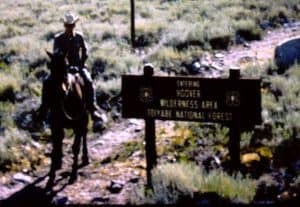“Most of my few horseback patrols went well.”
I spent a few days each summer in the Hoover Wilderness where increasing back-country travel was increasing the risk of human-caused fires. Most of my wilderness patrols were on foot, but on rare occasions I rode a horse. In 1965, for example, I rode the rugged and scenic Green Creek drainage on a mountain-wise black mare named Coaly, talking with occasional wilderness travelers as I passed Green Lake, Nutter Lake, Gilman Lake, and the Hoover Lakes en route Summit Lake on the Toiyabe National Forest-Yosemite National Park border.
Most of my few horseback patrols went well, but I darn near wound up finishing one of them on foot.
That was the time Fire Control Officer Marion Hysell and I rode up to a little lake above Barney Lake and below Hunewill Peak to rebuild rock fireplaces and erect a sign. After finishing the work and eating lunch, we began the return trip on the two big black horses hired from the Mono Village pack station for the day’s work. About half way down to the junction with the Barney Lake trail, Marion and I met a group of hikers. They were bound for the little lake we had just left, and we dismounted to talk with them. About what, I can’t remember. What I can remember is my mount suddenly deciding to quit the country. He reared, yanked the loosely-held reins from my hands, and launched himself down the trail toward the pack station more than four miles away.
“Now you’re a hiker, too!” one of the hikers observed with thinly veiled satisfaction.
Instead of explaining my preference for shank’s mare, I excused myself with something like “Darned if I’ll walk back to Mono Village!” and lit out after the horse.
“He’ll never catch it,” one of the hikers predicted.
But there was a chance. I recalled the series of switchbacks in the trail up this steep slope, and hoped they’d work in my favor. I plunged off the trail and downslope over boulders and through thickets to head off the fugitive mount.
The first time I tumbled back onto the trail I was just too late. Down the trail to my right, the horse was hightailing into the next switchback. Back into the woods I plunged, again careering downhill as aspen branches slapped my face and mountain mahogany slowed my progress.
Within moments I was back on the trail, and this time ahead of the game. Off to my right, the horse had just turned out of the switchback and was thundering toward me, eyes wild and ears back in what looked a lot like determination. I was determined, too, and as the big black tried to evade me I grabbed its reins just below the bit, yanked down hard, and wrestled it to a kicking, snorting, dusty stop. Its reigns tight in my grasp, the horse followed me back up the trail. Would catching this runaway redeem me in Marion’s eyes? In the eyes of the hikers?
By the time I had led the recaptured mount back up the trail, to where Marion and the hikers were waiting to see if I would walk or ride home, I had managed to brush off dust and leaves and tuck in my shirt. I had also reviewed and rejected every alibi east of the Sierra. The truth of what had happened was obvious. Marion grinned. He seemed satisfied at the fact I had caught the horse. The hikers seemed impressed by the same fact.
Wishing the hikers well, we mounted up to resume our ride back to the pack station.
Adapted from the 2018 third edition of Toiyabe Patrol, the writer’s memoir of five U.S. Forest Service summers on the Toiyabe National Forest in the 1960s.
